Digital Audience Survey | Findings
July 2021
Contents
Themes
Latest findings from The Audience Agency's Digital Audience Survey show how audiences have responded to arts, culture and heritage organisations moving so much of their offering online during the COVID-19 lock-down period.
This 5 minute survey, deployed by organisations via their websites, social media and other e-communications, invites online audiences to help organisations to better understand:
- Profiles
- Motivations
- Online habits
- Changes through COVID-19
Key Findings | June 2021
This summary (covering findings from all respondents to the Digital Audience Survey up to June 2021) focuses on three particular findings:
- Age. Respondents are getting older (and are older than in-person attenders)
- Attendance. There is an increasing proportion of previous in-person visitors (although, of course, with longer since they have been)
- Motivations. Reasons for visiting online have been changing (fewer mentioned, but emotional motivations remaining important, especially for younger audiences).
Various other measures are included in the appendix, for general interest.
1. Age of Respondents
We’ve seen before that online audiences responding to the Digital Audience survey are more likely than in person attenders (from Audience Finder 2018/19 surveys) to:
- Be older: 55% aged 55+ (vs 44%)
- Be female: 68% (vs 64%)
- Have a disability: 12.5% (vs 9%)
- Live outside the UK: 12% (vs 5%).
But the proportion of older audiences is increasing:
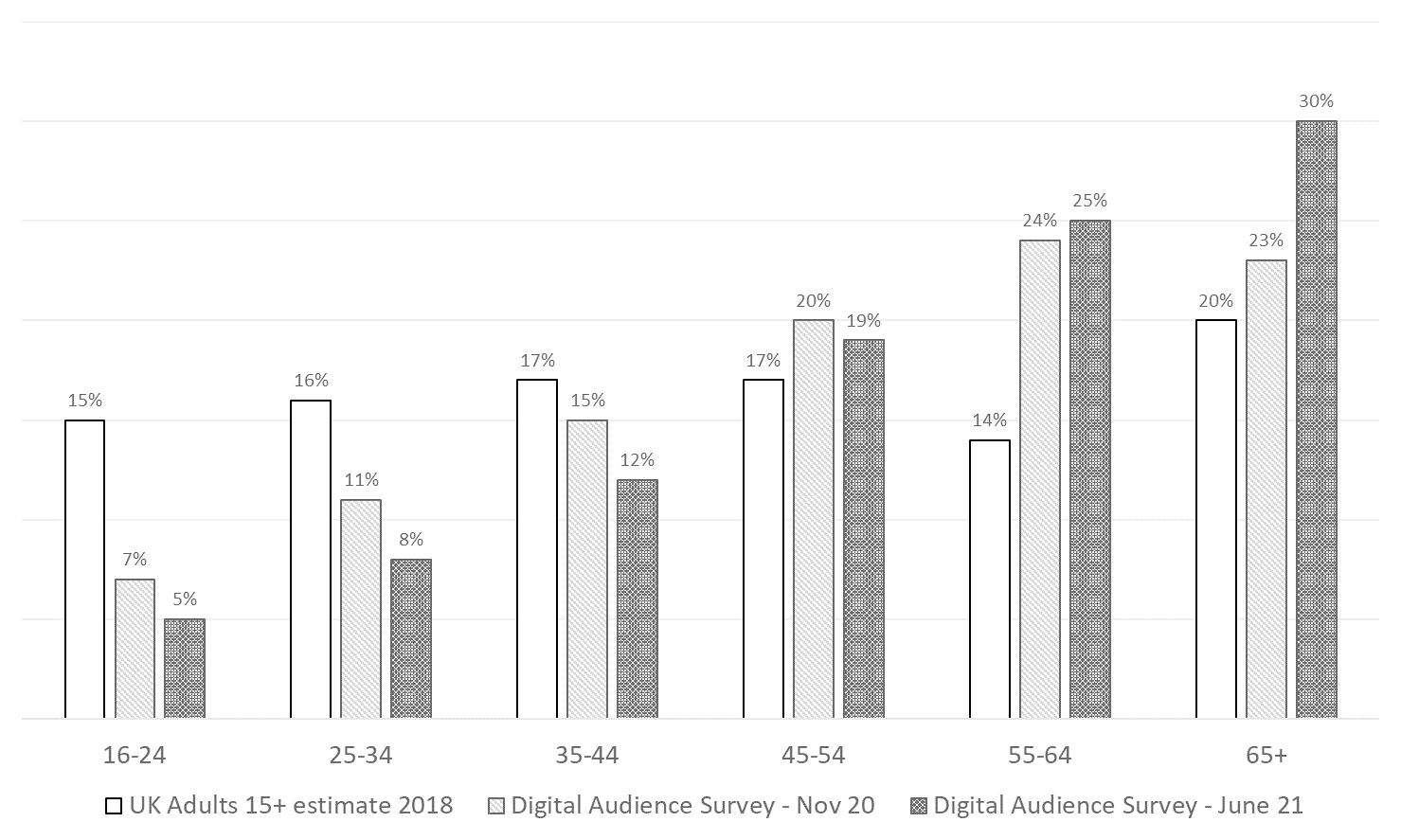
The age profile of this online audience is older than the population and older than it was in November last year. This is particularly true of gallery online audiences, only 9% of whom were under 35 (cf. 31% of the population). In November just under half of audiences were 55+, whereas now it is 60%.
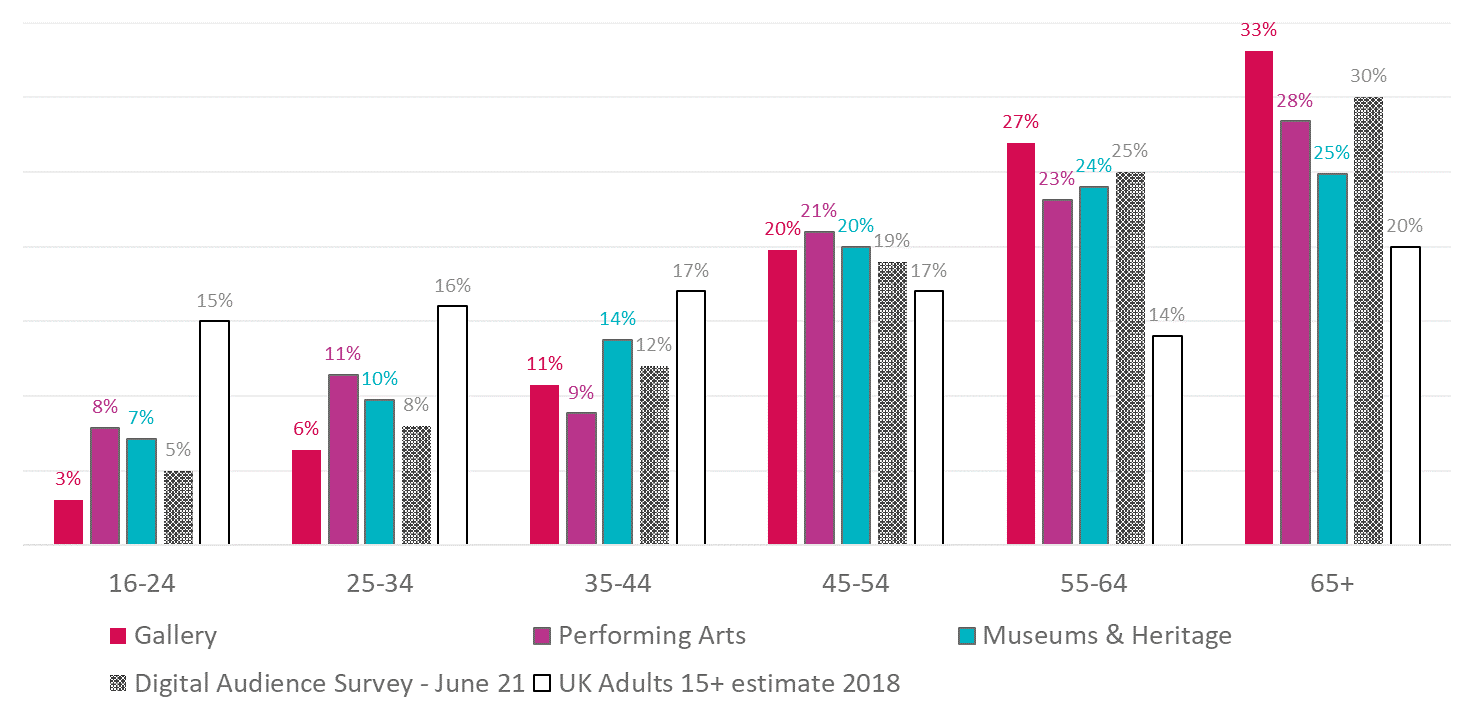
2. Previous Attendance
The proportion of ‘first time’ visitors rose from August to November 2020 (27% to 34%) but had fallen back a little by June 2021 (30%). Who is visiting is — to some extent — settling down. But it also seems to settling into previous in-person attenders. Whereas 69% of first time web visitors haven’t attended in person before, that was true of only 15% of those who engaged online ‘at least once a week’, or ‘at least once a month’.
These together have created a shift in the in-person visit history of online engagers. The proportion of those who have visited the organisation in person before has fallen (from 38% up to 41% but then down to 34% in Aug ’20, Nov ’20 and Jun ’21 respectively), but so — for obvious reasons — has the proportion who have visited in the last 12 months (41%, 37%, 31%). Thus the proportion who have attended before, but only more than a year ago, has jumped in the last year (22%, 21%, 35%). There has been a big increase since November in the proportion who had visited between one and two years ago (10-21%).
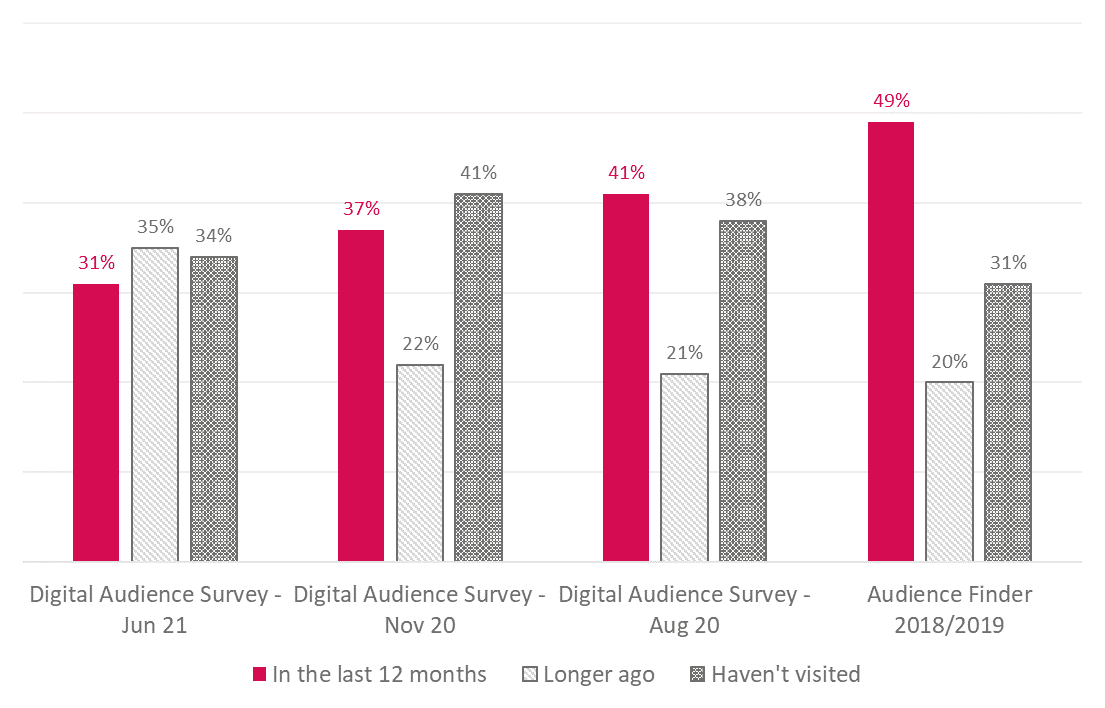
One quirk of these trends is that at each measurement point, the most common time since visiting was different (August: In the last 12 months; November: never; June: Longer ago than the last 12 months). This potentially makes for a more challenging audiences to cater to, with three evenly sized groups with very different in-person experience of the organisation.

It remains the case that those who engage online most often are most likely to be recent in-person attenders:

3. Motivations
The main difference in terms of motivations is lower numbers of motivations listed across the board:
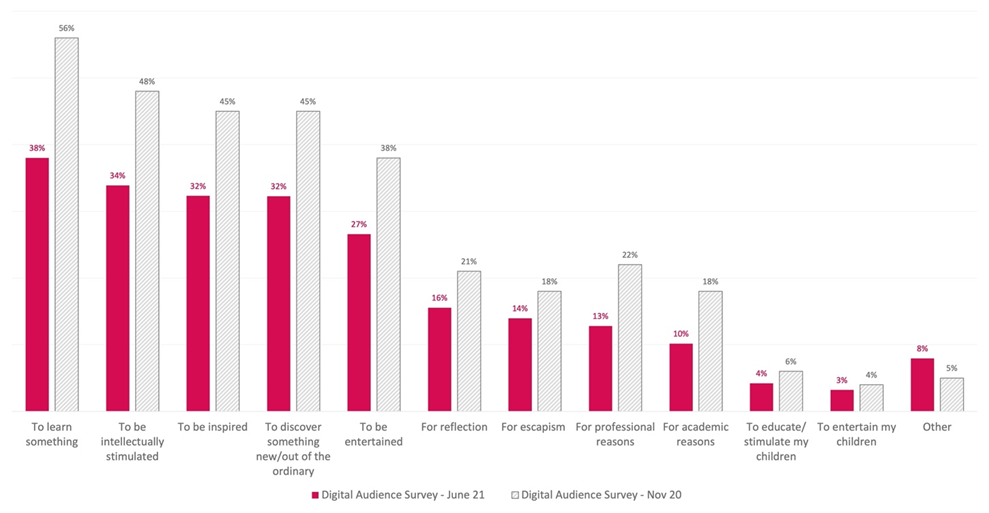
Despite drops in professional and academic motivations, intellectual motivations remain highest. However, emotional reasons remain important:
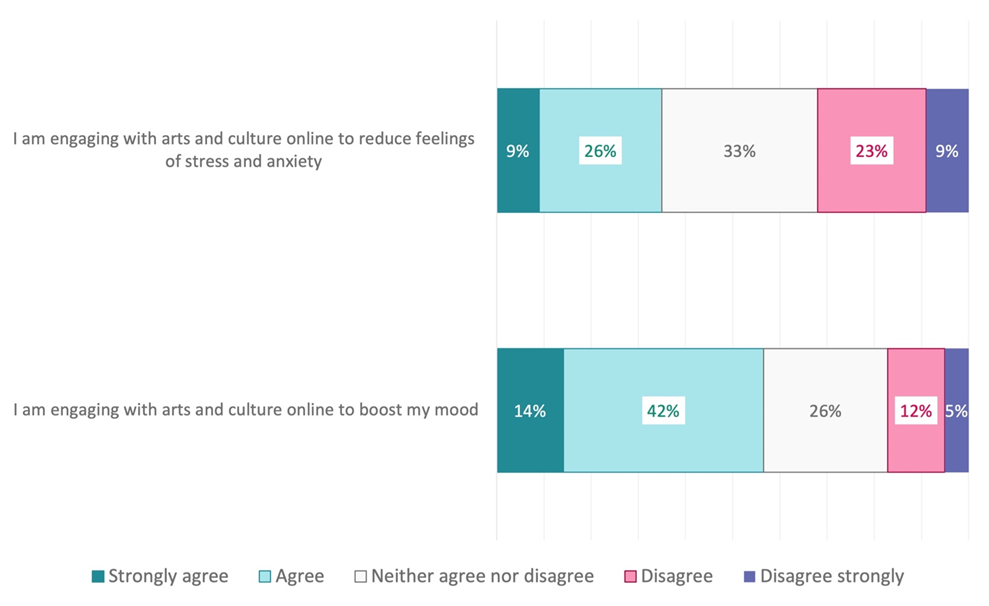
These motivations remain higher for younger audiences. For example, the statement ‘I’m engaging to reduce stress/anxiety’ had only a slightly greater proportion agreeing than disagreeing among respondents overall, but a clear majority agreeing among 16-34s. ‘I’m engaging to improve my mood’ has a majority agreeing for all ages, but more so for the 16-34s:
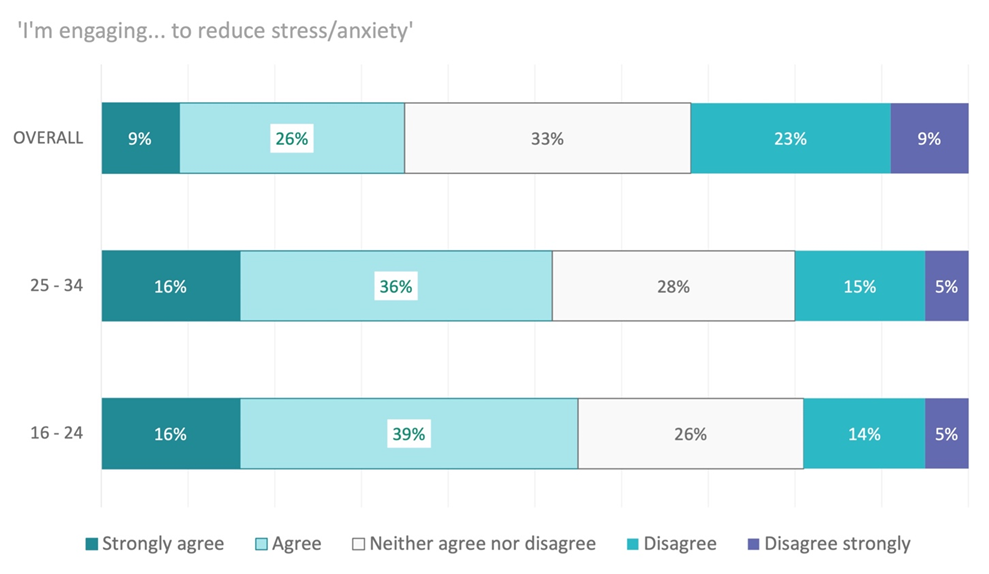
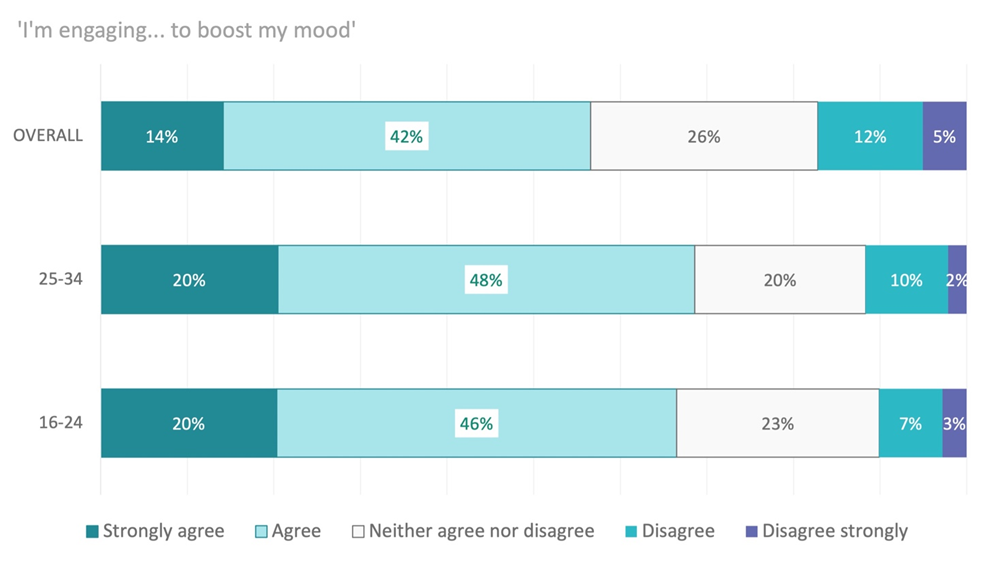
Key Findings | December 2020
1. Key Findings about Audiences' Profiles
- As is true of the Audience Finder data benchmark for onsite audiences, Dormitory Dependables and Commuterland Culturebuffs are the best represented Audience Spectrum groups in the Digital Audience survey. This is likely linked to the fact that their in-person attendance is perhaps limited, relative to their levels of interest, because they live away from urban centres. So digital activity allows them to engage in higher proportions when geography is removed as a factor.
- Experience Seekers though are engaging significantly more online, making up 13% of audiences, rather than the typical physical 6%.
- While Performing Arts has a balanced aged demographic, more than half of audiences engaging with Museums and Heritage online are aged 55+ and just under half of Gallery visitors are 55+.
- Encouragingly, the number of audiences identifying as disabled people engaging online is higher than onsite, a factor that we'll be looking at in more detail in the future.
Audience Spectrum
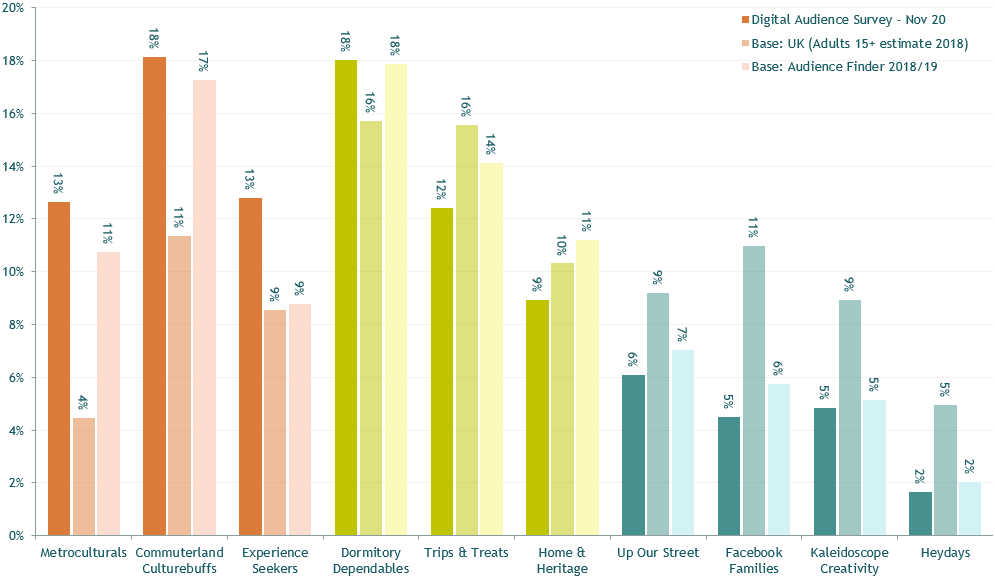
In terms of Audience Spectrum, the profile of audiences engaging with online content since lock-down has been similar to the make-up of physical audiences in 2018/2019 (Audience Finder Benchmark). This includes:
- The typical over-representation of high and medium engaged groups - particularly Metroculturals, Commuterland Culturebuffs and Dormitory Dependables
- Compared to the Digital Audience Survey in August 2020 there has been a slight decrease in the medium culturally engaged Dormitory Dependables and Trips & Treats reflecting the family make-up of these segments, where many children have returned to school. And an increase in all higher culturally engaged groups, who are in professions more likely to require continued homeworking or particularly for Experience Seekers which has a high proportion of students facing home learning.
- Lower engaged groups make up just 17% of online audiences, slightly below the physical arts and culture attendance average of 20% and half as prominent as in the population, of which these groups constitute 34%.
Age
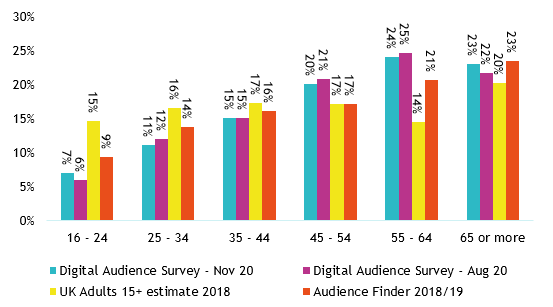
The Digital Audience age profile has lower proportions of younger audiences, both in comparison to the UK population and the Audience Finder benchmark. When the sample is split by organisation type, its apparent that:
- Performing Arts has a particularly balanced age demographic, that aligns quite closely with the UK population.
- Museums and Heritage organisations only manage to attract 14% 16-34 year olds, compared to the Performing Arts which attract 24%. In fact, over half of Museums and Heritage online audiences are 55+.
- Galleries similarly only attract 17% 16-34 year olds and just under half of online audiences are 55+.
2. Key Findings about Website Visitation Habits
- Around one in four of the Digital Survey respondents visit the organisations’ websites frequently – 29% visit at least once a week or more.
- While a third of respondents (34%) are first time website visitors - a 7% increase in proportion of first time visitors from Aug 20 (27%).
- Just over half (55%) of these high frequency website visitors, have attended that organisation in person in the last 12 months.
- Over a third (41%) have only engaged with the organisation digitally, having never visited the organisation in person.
- 74% of first time website visitors have never visited the organisation in person.
- Around one in three (37%) website visitors, though, are also frequent onsite attenders, having visited the organisation in person, within the last 12 months.
- 80% of first time website visitors to Galleries have never physically attended the organisations. This is compared to 61% and 65% respectively for Museum & Heritage and Performing Arts organisations.
- There are many non-UK digital audience members. Almost a third (29%) of the digital-only visitors live outside of the UK.
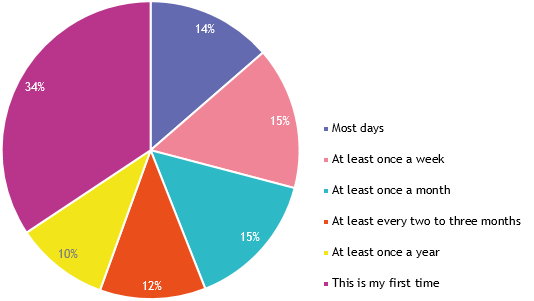
Around one in four of the Digital Survey respondents visit the organisations’ websites frequently – 29% visit at least once a week or more.
While a third of respondents (34%) are first time website visitors - a 7% increase in proportion of first time visitors from Aug 20 (27%).
- When comparing Gallery, Museum & Heritage and Performing Arts visitors, Galleries have a significantly higher proportion of first-time website visitors at 49% compared to 20% for Museum & Heritage and Performing Arts.
Of the respondents that have visited at least every two months or more, 23% say that their frequency has increased significantly since the COVID-19 crisis and a further 35% say it has increased somewhat.
- When comparing artforms, Museum & Heritage and Performing Arts have a higher proportion of visitors that say that their frequency of visits has increased significantly since the COVID-19 crisis, at around a third compared to 19% for Galleries.
Compared to physical attendance

Respondents were asked about the frequency of both their website visitation and their physical attendance of the organisation. Predictably, there is strong correlation between frequency of website and physical visits. However, there are some interesting differences between first time visitors to the organisation's website and frequent flyers.
First time vs frequent website visitors
- Just over half (55%) of these high frequency website visitors, have attended that organisation in person in the last 12 months.
- Over a third (41%) have only engaged with the organisation digitally, having never visited the organisation in person.
- 74% of first time website visitors have never visited the organisation in person.
- Around one in three (37%) website visitors, though, are also frequent onsite attenders, having visited the organisation in person, within the last 12 months.
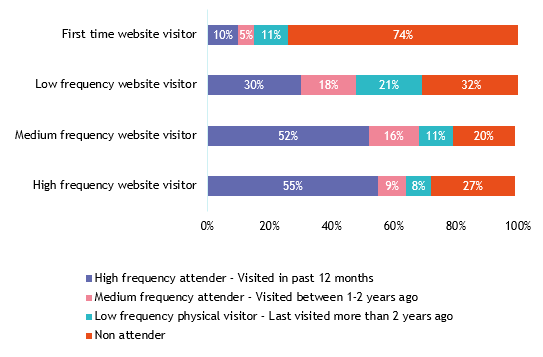
The profile of web vs physical attendance between Museums & Heritage, Galleries and Performing Arts venues differs quite substantially when comparing first time visitors and high frequency website visitors.
- 80% of first time website visitors to Galleries have never physically attended the organisations. This is compared to 61% and 65% respectively for Museum & Heritage and Performing Arts organisations.
- 37% and 35% of high frequency website visitors to Galleries and Museums & Heritage organizations have never physically attended the organisations. This is compared to just 24% of performing arts.
3. Key Findings about Motivations for Engaging with Arts and Culture Online
- A large proportion – 59% have discovered new forms of art and culture during this period.
- Respondents identifying as BAME (71%) were mostly likely to have discovered new forms of art and culture during this period, compared to 59% overall.
- 61% saying that they are viewing more arts and cultural content online during this period.
- Performing Arts visitors were more likely to be viewing more arts and cultural content online during this period at 68% compared to 61% overall and 56% for Galleries.
- Over half of respondents identifying as disabled agreed with the statement ‘I am engaging with arts and culture online to reduce feelings of stress and anxiety.’
- In total 52%/54% of 16-24 and 25-34 year olds either agreed or agreed strongly with the statement, compared to 24% of over 65s.
- 58% say that they are engaging with arts and culture online to boost their mood.
- Around two thirds of 16-24 and 25-34 year olds either agreed or agreed strongly with the statement ‘I am engaging with arts and culture online to boost my mood’, 65% and 70% respectively, compared to 49% of over 65s.
The questionnaire asks respondents whether they agree/disagree with the following 5 statements:
- I have discovered new forms of arts and culture online.
- The types of art and cultural content that I am viewing online is similar to what I would normally see in person.
- I am viewing more online arts and cultural content now than I did before the COVID-19 crisis.
- I am engaging with arts and culture online to reduce feelings of stress and anxiety.
- I am engaging with arts and culture online to boost my mood.

- A large proportion – 59% have discovered new forms of art and culture during this period.
- 61% saying that they are viewing more arts and cultural content online during this period.
- 58% say that they are engaging with arts and culture online to boost their mood.
These were then cross-tabbed by Audience Spectrum (grouped by level of engagement), age, artform, disability and ethnicity, with some notable differences indicated below. Of particular interest were the differences in responses to the two statements regarding emotional motivations.
Responses by Ethnicity
- Performing Arts visitors were more likely to be viewing more arts and cultural content online during this period at 68% compared to 61% overall.
- This was notably lower for Galleries at 56%.
- Performing Arts visitors were more likely to be engaging with arts and culture online to boost their mood at 65% compared to 58% overall.
- This was notably lower for Galleries at 53%
Responses by Disability

A higher proportion of Digital Audience Survey respondents identifying as disabled were likely to:
- Have discovered new forms of art and culture during this period at 66% compared to 59% overall.
- Be engaging with arts and culture online to boost their mood at 66% compared to 58% overall.
- Strongly agreed or agreed with the statement ‘I am engaging with arts and culture online to reduce feelings of stress and anxiety.’ at 66% compared to 37% overall.
Responses by Age
Younger audiences were more likely to agree strongly with this statement ‘I am engaging with arts and culture online to boost my mood.’
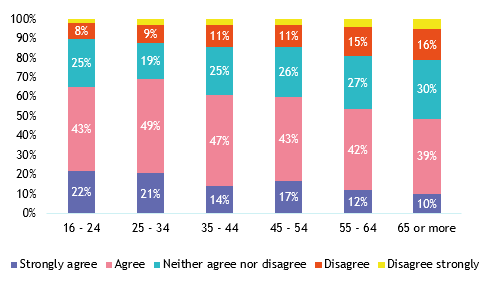
- 22%/21% of 16-24 and 25-34 year olds agreed strongly, compared to 10% of over 65s.
- In total 65% and 70% of 16-24 and 25-34 year olds either agreed or agreed strongly with the statement, compared to 49% of over 65s.
Younger audiences were also more likely to agree strongly with this statement ‘I am engaging with arts and culture online to reduce feelings of stress and anxiety.’:
- 16% of 16-24 year olds agreed strongly, compared to 5% of over 65s.
- In total 52% of 16-24 year olds either agreed or agreed strongly with the statement, compared to 24% of over 65s.
Responses by Audience Spectrum segment
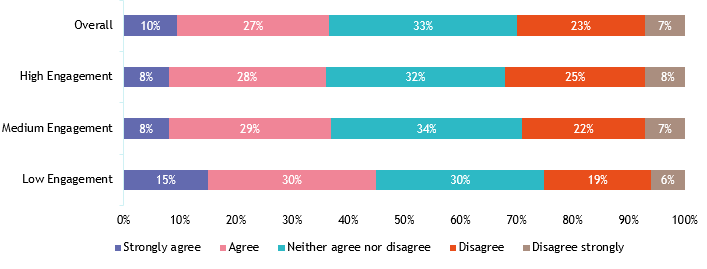
‘I am engaging with arts and culture online to reduce feelings of stress and anxiety.’
- 15% of usually low cultural engagement respondents strongly agreed with the statement, compared to just 8% of high engagers.
- In total nearly half of low engagers (45%) either agreed or agreed strongly with the statement, compared to 36% of high engagers.
